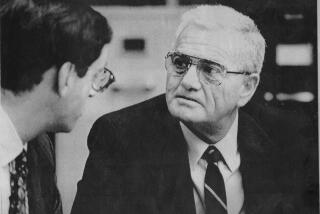Who Knew Croquet Could Make a Difference?
- Share via
The long-awaited results are in. After five years and $40 million, the Friskel Foundation has announced the findings of its landmark study on crime in America, entitled “Crime: What We Found Out for $40 Mil.”
Foundation President Bob Friskel commissioned the study after the disappearance of his beloved Mercury Sable. In 1992, he recruited several of the nation’s top criminologists. Interestingly, the team he assembled was also a “Who’s Who” of American track and field.
Friskel instructed the group to research the root causes of crime and to follow up on any leads relating to his mid-size beauty. Led by hammer thrower Ernest Philo, the ensemble embarked on the most ambitious, and expensive, study on lawlessness seen in decades.
Philo and steeple-chasing phenom Garston Meadows persuaded the team to first explore attitudes toward crime.
Over the course of eight months, 20,000 people were contacted. Surprisingly, 77% of criminal respondents described their attitude toward crime as “fundamentally in favor.” More than 80% of law-abiding citizens expressed disdain for the criminal element.
Another factor explored by the team was that of climate. “What is the effect of weather on crime?” was the question asked 23,000 convicted felons. Sixty-five percent responded that snow was a strong deterrent to absconding with livestock. Thirty-five percent stated that dew was only a consideration if they were otherwise ambivalent about the crime they were contemplating.
The team’s findings on the educational backgrounds of criminals were illuminating as well. After submitting questionnaires to chain-gang members at break time, the researchers collected data that proved the following: A vast majority of lifelong criminals still question the need for algebra in their lives.
Consistent with earlier studies, the Friskel contingent determined economic conditions to be an integral factor in crime. Most echoed the sentiments of one respondent who said that if he were a rich man, he would not break into song, though a soliloquy was not ruled out.
On the sensitive issue of auto theft, most indicated that what they stole was largely determined by what they were currently driving. No one admitted to stealing a Sable; most cited multiple recalls as the cause.
The influence of media was an area studied for a full two years. Criminals pointed to the abrasiveness of the new networks for “forcing us out of the house.” Fifty-five percent of habitual criminals commended the various highway patrol shows for videotaping their apartments, something many had intended to do as per instructions from their insurance companies. “You can’t make a claim without it” was the much-heard refrain.
What is the effect of aging on the criminal mind? That question seized the group’s attention for most of 1995. By its own admission, the group’s findings are surprising. Despite long-held assumptions, the theft of Sweet ‘N’ Low is not a crime of the elderly. Says one 28-year-old Alabama inmate: “Frankly, those pink packets don’t last long here either.”
Recreational activity, or lack thereof, was also a subject of inquiry. Javelin spotter Hornst Felby opined that idle time was the true culprit in engendering criminality. To buttress his assertion, Felby asked 45 death row inmates what effect more recreational outlets would have had on their wayward lives.
Fourteen responded that the paucity of croquet lawns was an ongoing irritant. Seventeen said that had the rules of badminton been clearly explained, they would have led far more honorable lives.
The remaining 14 spoke bitterly of having the History Channel cut off at 4 p.m. Said one knowledge-starved prisoner: “Had I known more about Henry Ford’s political leanings, I never would have taken that Sable.”
More to Read
Sign up for Essential California
The most important California stories and recommendations in your inbox every morning.
You may occasionally receive promotional content from the Los Angeles Times.













